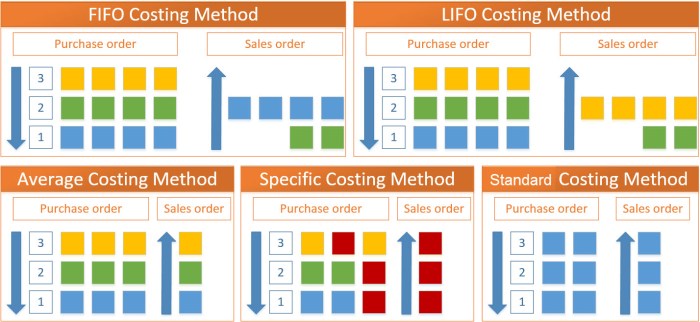In almost all NAV implementations, we need to configure and use costing (inventory, manufacturing, jobs…). This is one of the main functionalities in all ERP solutions as well as in NAV. Because of that I will prepare the series of costing articles with an overview of the principles used within the costing area.
In this first part, I will make a small introduction about costing methods. Microsoft Dynamics NAV supports the five following costing methods:
- FIFO
- LIFO
- Average
- Specific
- Standard
Now, in the following part I will just describe these costing types.

FIFO
The FIFO costing method means “First In First Out”. It first assigns the value of the increases with the earliest posting dates on inventory. COGS is calculated using the value of the first inventory acquisitions.
An item’s unit cost is the actual value of any receipt of the item, selected by this explained FIFO rule. In inventory valuation, it is assumed that the first items placed in inventory are sold first.
LIFO
The LIFO costing method means “Last In First Out”. It first assigns the value of the increases with the most recent posting dates on inventory. COGS is calculated using the value of the most recent inventory acquisitions.
An item’s unit cost is the actual value of any receipt of the item, selected by previous explained LIFO rule. In inventory valuation, it is assumed that the last items placed in inventory are sold first.
Average
The Average costing method calculates a weighted average of the remaining inventory on the last date of the average cost period in which the inventory decrease was posted. COGS is calculated using the average value of the inventory acquisitions.
An item’s unit cost is calculated as the average unit cost at each point in time after a purchase. For inventory valuation, it is assumes that all inventories are sold simultaneously.
Specific
The Specific costing method overrides assumption about how cost flows from inventory increase to inventory decrease with the accurate cost information, creating a fixed application between these entries.
An item’s unit cost is the exact cost at which the particular unit was received.
Standard
The Standard costing method works with predetermined costs (rather than actual cost) for all inventory increases and it affects the value of the inventory decreases.
An item’s unit cost is preset based on estimated. When the actual cost is realized later, the standard cost must be adjusted to the actual cost through variance values.
Conclusion
This was only small introduction about costing types as preparation for the more advance knowledge about using costing in Microsoft Dynamics NAV. In the following articles, I’ll describe more about facts when users need to use these costing methods as best practices. I’ll write about all details in posting results and posting rules as well.
Excellent article, thanks! Am I right in assuming that, in the diagram, the bottom right rectangle should be labeled “Standard Costing Method”?
LikeLike
Thanks. You are in right. I’ll change it 🙂
LikeLike
[…] Bron : Totovic NAV Blog Lees meer… […]
LikeLike
[…] The choice of a costing method has two consequences. It determines which purchase entries and sales entries will be applied to each other when you post a document. This is the application method part of the costing method and I’ve already wrote about it. It also influences the unit cost calculation, which is itself used for posting to the general ledger. This is the cost flow assumption part of the costing method. I’ve already wrote basically about costing methods in Microsoft Dynamics NAV. […]
LikeLike
Hi Alex
Good job with this article – clearly explanation.
Dynamics NAV offer also one another costing metod called FEFO First-Expired-First-Out
https://msdn.microsoft.com/en-us/library/hh173733(v=nav.90).aspx
Most peoples forgot about it because it base on WMS, but this method is important in pharmacy or food industry – anywhere item expire quickly.
LikeLike
[…] 2つ目は、単価計算も影響し、単価自体も総勘定元帳への計上時に使用されます。原価フローの前提については、こちらの記事から確認できます(英語のみ – 和訳予定) […]
LikeLike